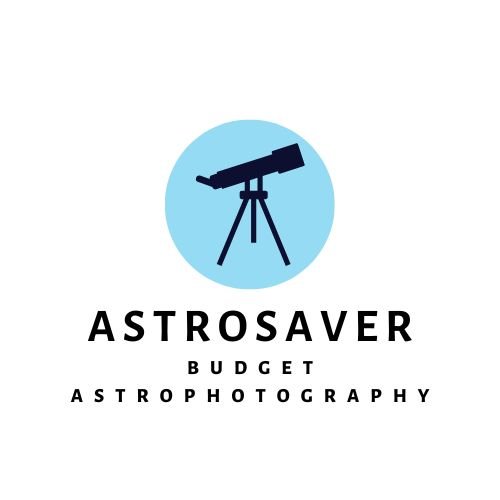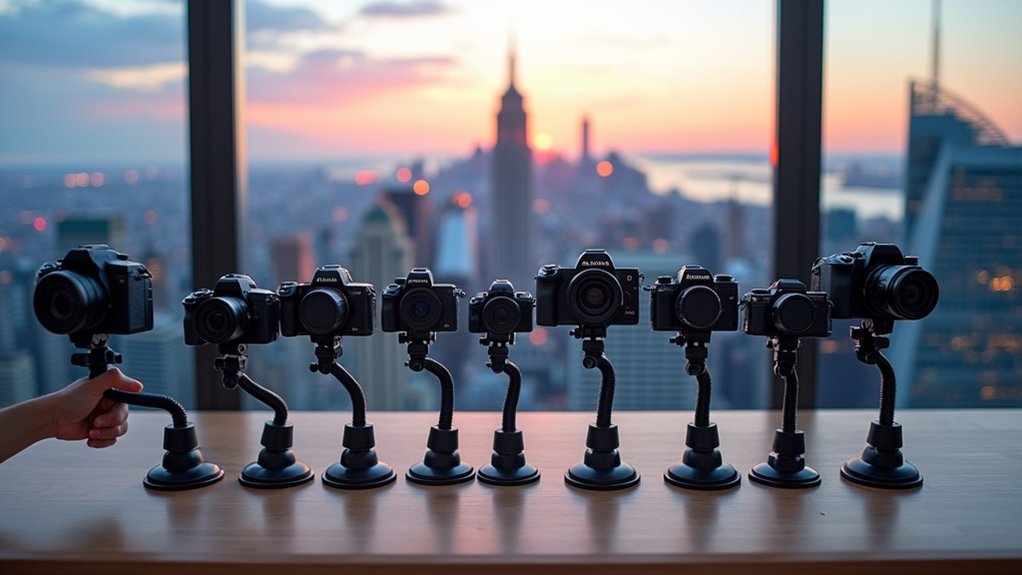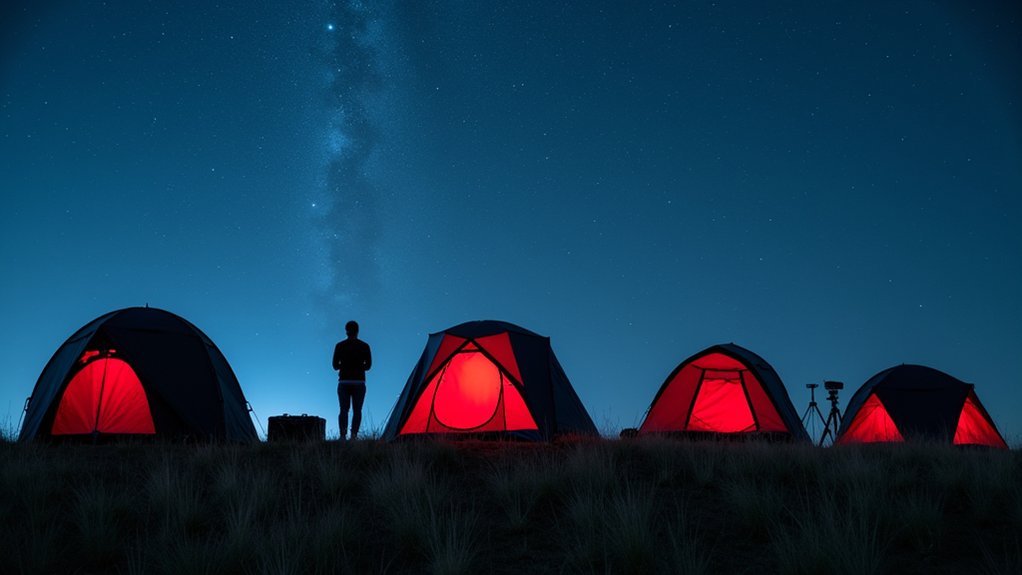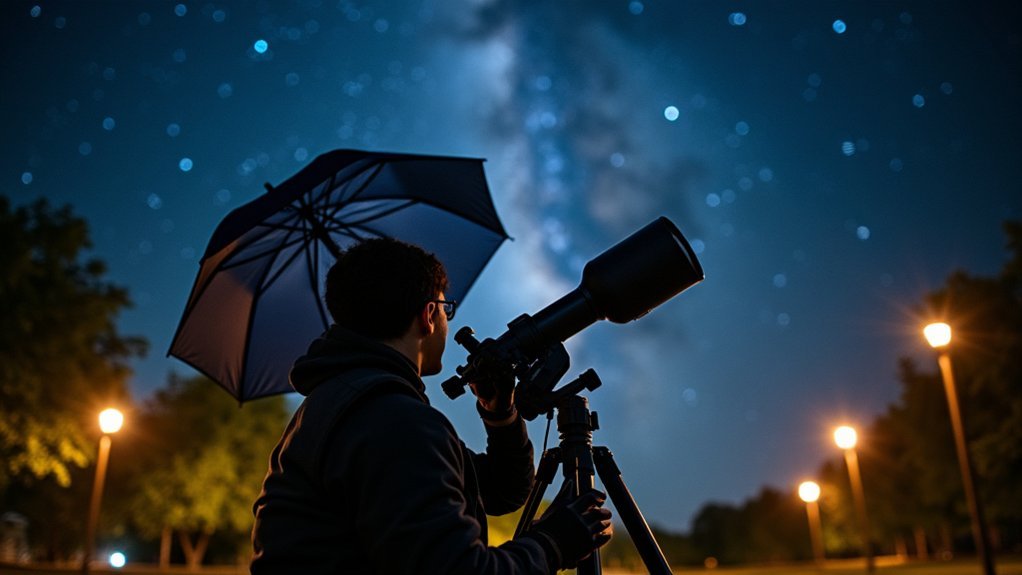For beginner moon photographers, try these five user-friendly software options: Adobe Lightroom for seamless Photoshop integration, Cyberlink PhotoDirector 365 for intuitive editing, DeepSkyStacker for free image stacking, Autostakkert for automatic frame alignment, and Registax 6 for enhancing lunar details with wavelet processing. You'll get sharper crater details and clearer surface features by stacking multiple exposures at low ISO settings. The right software combination will transform your blurry moon shots into stunning celestial portraits.
5 Best Moon Photography Software Programs For Beginners

When you're just starting out with lunar photography, choosing the right software can make all the difference between frustration and success.
Look for programs with intuitive interfaces and vital editing tools.
Adobe Lightroom is extensive and integrates seamlessly with Photoshop for advanced edits.
Adobe Lightroom's comprehensive toolset pairs perfectly with Photoshop, giving moon photographers a complete editing ecosystem for stunning results.
If you're on Windows, Corel PaintShop Pro offers AI-powered tools that simplify your workflow.
Cyberlink PhotoDirector 365 stands out for beginners with its user-friendly approach and regular updates. It includes various social media-friendly features that make sharing your moon photos quick and easy.
Don't want to spend money? Try GIMP or Darktable.
These free alternatives provide robust editing capabilities including brightness adjustment, noise reduction, and sharpening—all essential for enhancing lunar details.
For specialized moon photography, consider Registax 6 or Autostakkert, which help you stack multiple images to create sharper, more detailed final photos.
Why Stacking Software Is Essential for Crisp Lunar Details
Among all the software options mentioned earlier, stacking programs represent the cornerstone of quality lunar photography. When you capture the Moon, each single shot contains random noise that obscures fine details.
Stacking software like AutoStakkert and Registax6 dramatically improves your signal-to-noise ratio by combining multiple exposures. You'll immediately notice sharper crater details and clearer surface features that remain hidden in individual frames.
The process works by averaging out random noise while reinforcing consistent lunar details. Using stacking software also simplifies your post-processing workflow, reducing the need for extensive noise reduction later.
For best results, capture multiple images at low ISO settings with fast shutter speeds, then let the stacking software select and combine your sharpest frames. Converting your images from RAW to TIFF or PNG formats before stacking will produce superior results, as these lossless formats preserve crucial details. The difference in clarity is truly remarkable.
Top Budget-Friendly Moon Stacking Programs for Noise Reduction

Quality lunar photography doesn't require expensive software to achieve stunning results. Three free Windows-based programs dominate the beginner-friendly space: DeepSkyStacker offers straightforward dark frame subtraction for thermal noise reduction, Autostakkert provides quality estimation to select only your sharpest frames, and Registax includes powerful wavelet processing to enhance details.
- DeepSkyStacker – Perfect first software with its intuitive interface and automatic alignment capabilities that'll boost your confidence as a lunar photographer.
- Autostakkert – Feels satisfying when it helps you eliminate poor frames, instantly improving your final image quality.
- Registax – Though challenging to master, delivers that thrilling moment when subtle lunar details suddenly pop. Particularly valuable for lunar photographers due to its specialized planetary imaging features.
- Image Stacking – The gratifying experience of watching noise dissolve as multiple images combine into one crisp shot.
Getting Started With Autostakkert: the Beginner's Choice
Three simple steps separate lunar photography beginners from their first professionally stacked moon image using Autostakkert. First, download this free software from the official website—it works on Windows natively and on Mac via emulation software.
Begin your lunar photography journey with Autostakkert—just download, load your footage, and stack your way to professional moon images.
Second, load your captured moon video (30 seconds to 2 minutes is ideal) into the program.
Third, select high-contrast areas as reference points for alignment before stacking your best frames.
Autostakkert's user-friendly interface balances simplicity with powerful processing capabilities. It automatically assesses frame quality, stabilizes images, and reduces noise by combining only the highest-quality frames. The software's quality graph helps you distinguish between good data (above 50) and poor-quality frames (below 50).
For best results, pair Autostakkert with PIPP for preprocessing and consider using Affinity Photo for final touch-ups after stacking. Even with basic equipment, you'll achieve cleaner, more detailed lunar images.
Comparing Registax and StarStax for Different Moon Phases

When selecting software for lunar photography, understanding the strengths of both RegiStax and StarStax can considerably impact your results across different moon phases.
RegiStax excels with planetary and lunar imaging, offering powerful wavelet processing that's particularly effective for full moon shots where detail is essential.
StarStax, with its simpler interface, provides an easier entry point for beginners, especially when capturing crescent or quarter phases. Many professionals actually recommend using AutoStakkert for stacking and then applying RegiStax for final sharpening.
- New Moon Simplicity – Save your processing efforts; neither software is needed when the moon isn't visible!
- Crescent Elegance – StarStax's user-friendly interface makes quick work of these simpler compositions.
- Quarter Phase Clarity – Both programs perform admirably, with StarStax being faster for beginners.
- Full Moon Detail – RegiStax's advanced wavelet processing reveals intricate lunar features impossible to capture in a single shot.
Frequently Asked Questions
How Much RAM Is Recommended for Processing High-Resolution Moon Photographs?
For high-resolution moon photographs, you'll want at least 8-16GB of RAM, but more is better. Your processing speed will improve considerably with 16GB+ RAM when handling large image stacks and detailed lunar shots.
Can Smartphone Photos of the Moon Be Effectively Processed With These Programs?
Yes, you can effectively process smartphone moon photos with these programs. Most editing software like Lightroom, Snapseed, and VSCO work well with smartphone images, especially if you've captured them in RAW format.
How Do I Calibrate Color Accuracy When Editing Moon Photographs?
To calibrate color accuracy when editing moon photographs, you'll need to adjust white balance, fine-tune tint, and use selective saturation. RAW format gives you more control during these adjustments in software like Lightroom or GIMP.
What File Formats Are Best for Preserving Lunar Detail During Editing?
RAW formats preserve the most lunar detail during editing. You'll want to use TIFF for lossless working files and high-quality JPG or JXL for sharing while maintaining the clarity you've captured.
Do I Need to Purchase Additional Plugins for Astrophotography-Specific Adjustments?
No, you don't need additional plugins for most astrophotography adjustments. Many free programs like RegiStax and Siril offer built-in features specifically designed for lunar photography, handling stacking, alignment, and detail enhancement effectively.
In Summary
You've now got five excellent software options to elevate your moon photography from blurry to breathtaking. Whether you choose Autostakkert for its user-friendly interface or explore Registax's wavelet capabilities, these programs will dramatically improve your lunar images. Don't let noise and atmospheric turbulence ruin your shots anymore. Start with these budget-friendly solutions tonight, and you'll quickly see why amateur astronomers rely on stacking software for those crisp, detailed moon photographs.





Leave a Reply